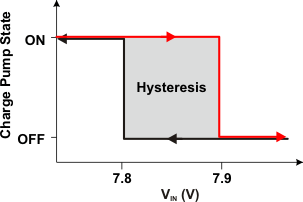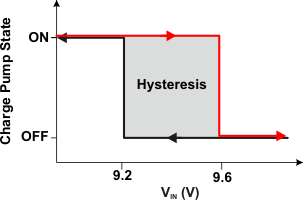JAJSFH9J March 2010 – March 2020 TPS7A60-Q1 , TPS7A61-Q1
PRODUCTION DATA.
- 1 特長
- 2 アプリケーション
- 3 概要
- 4 改訂履歴
- 5 Device Comparison Table
- 6 Pin Configuration and Functions
- 7 Specifications
- 8 Detailed Description
- 9 Application and Implementation
- 10Power Supply Recommendations
- 11Layout
- 12デバイスおよびドキュメントのサポート
- 13メカニカル、パッケージ、および注文情報
パッケージ・オプション
メカニカル・データ(パッケージ|ピン)
- KVU|5
サーマルパッド・メカニカル・データ
- KVU|5
発注情報
8.3.2 Charge Pump Operation
These devices have an internal charge pump which turns on or off depending on the input voltage and the output current. The charge-pump switching circuitry does not cause conducted emissions to exceed required thresholds on the input-voltage line. For a given output current, the charge pump stays on at lower input voltages and turns off at higher input voltages. The charge-pump switching thresholds are hysteretic. Figure 19 and Figure 20 show typical switching thresholds for the charge pump at light (IOUT < approximately 2 mA) and heavy (IOUT > approximately 2 mA) loads, respectively.
 Figure 19. Charge Pump Operation at Light Loads
Figure 19. Charge Pump Operation at Light Loads  Figure 20. Charge Pump Operation at Heavy Loads
Figure 20. Charge Pump Operation at Heavy Loads